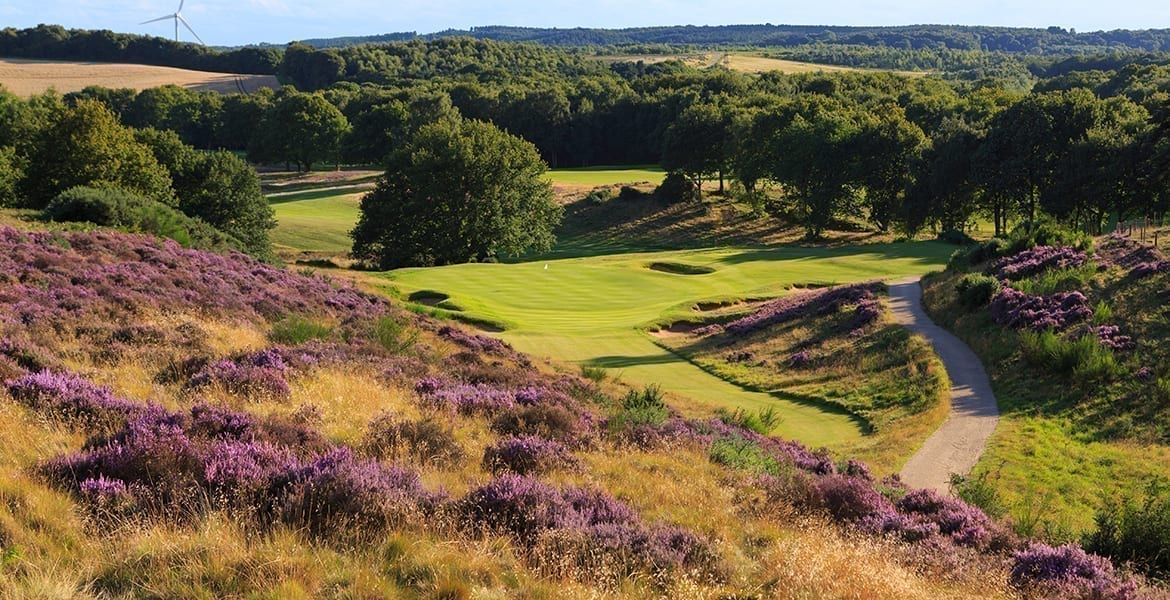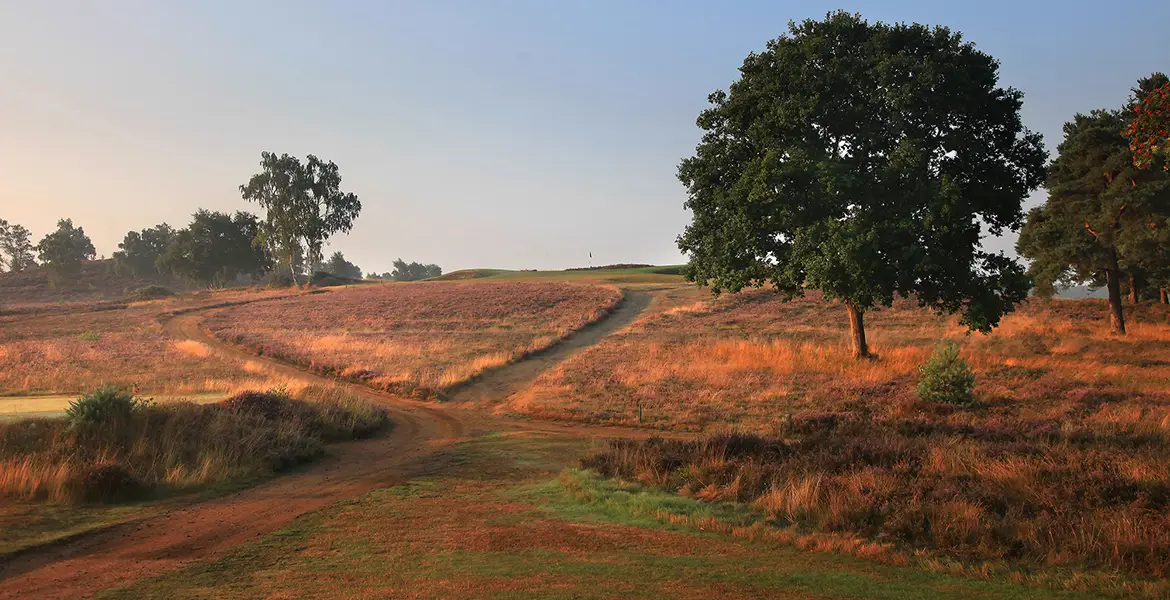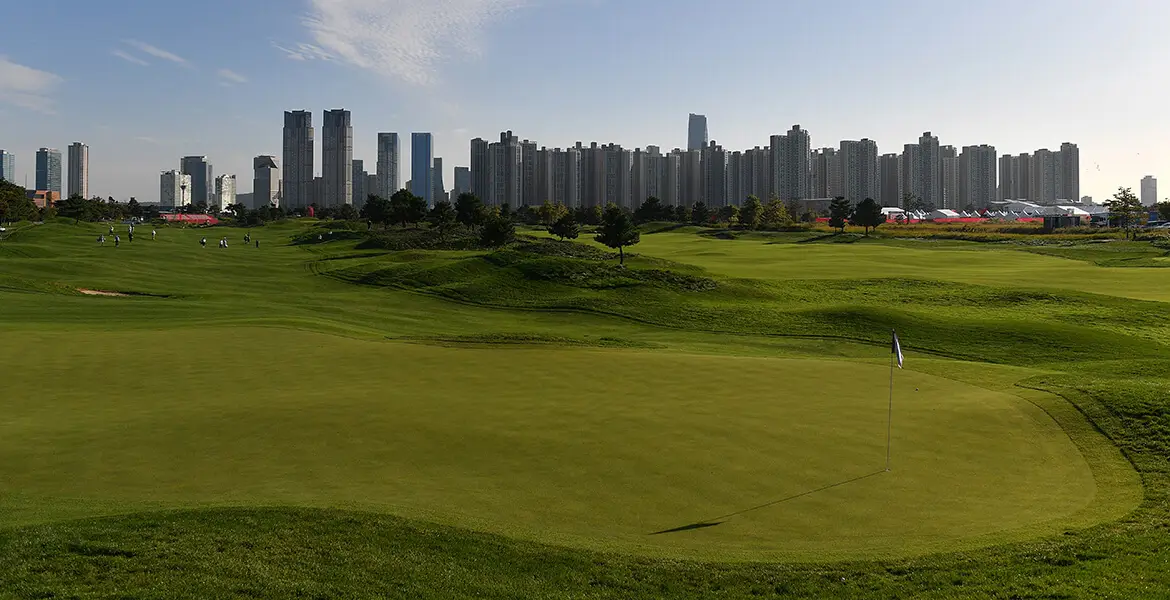
Flying to England could mean arrival at Heathrow, Gatwick, Birmingham, or Manchester Airports which gives you the opportunity to check out some of England’s great, but unheralded, courses. Here are ten of our favorites. They’re all private, but private clubs in the UK operate differently to those in the U.S. A phone call ahead or email enquiry, a competent golf game, and the payment of a green fee are all you need to ensure a tee time.
LONDON

Hindhead
A quartet of England’s most celebrated gentlemen have close ties to this beautiful wooded heathland course in Surrey’s southwest corner, the first 12 holes of which opened for play in 1904. The club’s co-founder and first President was Sherlock Holmes-creator Sir Arthur Conan Doyle, the course’s designer five-time Open Championship winner J.H. Taylor. David Lloyd George, Prime Minister from 1916 to 1922, was made an honorary life member the year he left Downing St. and, more recently, the club has become associated with another honorary life member, Peter Alliss, who calls Hindhead “one of my favourite courses of all time.” After 18 holes, stop for a pint in the Alliss Bar.
Drive time from Heathrow: 40 minutes
hindheadgolfclub.co.uk

Camberley Heath
Located 34 miles southwest of Buckingham Palace, and 21 miles from Heathrow Airport, Camberley Heath is a glorious Surrey heathland/pine forest course that celebrated its centenary in 2013. Though a number of modifications have occurred at various stages throughout the last 100 years, today’s routing and holes are very similar to those H.S. Colt built on this compact 135-acre site.
Colt-specialist Frank Pont began a renovation project in the winter of 2015/16 alongside master shaper George Waters.
Drive time from Heathrow: 30 minutes
camberleyheathgolfclub.co.uk
Hankley Common
Hankley’s first nine holes opened in May 1897, six months after the club was formed. Following an invitation from the club captain in February 1921, James Braid visited the course, and the nine holes he devised were all in play by June 1924. Seven years later, the club asked H.S. Colt to lengthen the course, the great English architect’s plan being fully realized by November 1935. Together with Camberley Heath and Hindhead, Hankley forms a superb cluster of courses in western Surrey that are not nearly as famous, exclusive, or difficult to gain access to as the county’s more prominent venues (Sunningdale, Wentworth, The Berkshire, Swinley Forest) slightly to the north and east, but the golf is still first-rate.
Drive time from Heathrow: 45 minutes
Hankley.co.uk

The Addington
Though he did join the architectural firm of Fowler and Simpson after World War I, J.F. Abercromby was by no means a prolific designer. Prior to founding and designing The Addington in 1912, “Aber” had built acclaimed courses at Coombe Hill and Worplesdon, and he would eventually be recognized as one of Britain’s best-ever architects. But his resume was light compared with some of his contemporaries. The site for the Addington, ten miles south of London near the suburb of Croydon, was considered a little wild for a golf course, but Abercromby was determined, and the course remains his crowning achievement.
Drive time from Heathrow: 60 minutes, or 40 minutes from Gatwick
addingtongolf.com
BIRMINGHAM

Little Aston
In 1908, eight years after his U.S. Open victory, and with four of his six Claret Jugs in the trophy cabinet, Harry Vardon was hired to lay out a course in the grounds of Little Aston Hall, eight miles north of Birmingham City Center. The fee was ten guineas—about $13. Taking advantage of the sandy, gravelly soil, Jersey’s most famous son designed a beguiling parkland course on 136 acres. Club members felt it a little too challenging though, so enlisted H.S. Colt in the mid 1920s to soften it some. With the acquisition of extra land, the club had grown to 176 acres by the mid 1960s, so further modifications were made. Today’s 6,813-yard course, however, still reveals much of Vardon’s ingenuity.
Drive time from Birmingham Airport: 25 minutes
littleastongolf.co.uk

Edgbaston
Completed in 1717, the handsome Edgbaston Hall is the third home of Edgbaston Golf Club, originally formed in 1896. The club first played at Warley Woods, four miles to the west of its present location, before moving two miles east to Harborne in 1910. The final move came in 1935 when the Birmingham Corporation (city council) made a compulsory purchase of the Harborne property. The club moved to Edgbaston, two miles south of Birmingham city center, and hired H.S. Colt to design them a new course. Colt was 67 and nearing the end of his career, but created a typically engaging layout that remains a hugely enjoyable test despite the fact its trees could probably do with a trim.
Drive time from Birmingham Airport: 25 minutes
edgbastongc.co.uk
Beau Desert
Twenty-five miles north of Birmingham, on land that was part of the Sixth Marquess of Anglesey’s Staffordshire estate, lies the glorious Beau Desert Golf Club. Opened in 1913, the course was designed by Herbert Fowler whose architectural career had yet to take off but whose initial effort—Walton Heath in 1902— was something of a triumph. Though not quite the archetypal sandy pine and heathland course in the Sunningdale or Swinley Forest mold, Beau Desert definitely has heathland characteristics and is commonly ranked among the top three or four courses in the Midlands.
Drive time from Birmingham Airport: 35 minutes
bdgc.co.uk
MANCHESTER
Manchester
Like Edgbaston, Manchester Golf Club currently resides at its third home after encroaching urbanization forced it to move from its first two. The club settled at Hopwood Park in 1910—28 years after it formed—and brought in H.S. Colt to design a course over 247 acres of largely barren moorland. It opened in March 1912. Since then tree growth has inevitably altered the nature of the course, although its fundamental moorland character remains evident. Now 500 yards longer than in Colt’s day, Manchester is still very much a Colt original, nonetheless.
Drive time from Manchester Airport: 35 minutes
mangc.co.uk
Bolton Old Links
Bolton Old Links G.C. has its roots in 1891 when a band of Bolton golfers laid out nine holes to the north of town. Disagreements with the landowner eventually resulted in the club splitting in two, however, half staying put and becoming Old Links G.C., the other half moving to Lostock Park, two miles to the south and becoming Bolton Lostock G.C. Old Links eventually resolved its issues with the landowner, and obtained additional land before calling in Alister MacKenzie in 1924. Luftwaffe bombs hit the course during the Manchester Blitz of 1940–41 adding contours that the club’s web site says “compliment Dr. Mackenzie’s.”
Drive time from Manchester Airport: 35 minutes
boltonoldlinksgolfclub.co.uk

Delamere Forest
The lovely Delamere Forest, 25 miles southwest of Manchester Airport, was originally laid out by Herbert Fowler and opened in April 1911, a year after the club had formed. Strangely, Fowler’s routing consisted of eight holes out and 10 back, a configuration the members had tired of by 1921 when they invited Fowler back. This time, the former county cricketer devised two nines, building seven new holes and remodeling 11 while retaining the course’s heathland stamp. In 1959, Hawtree & Son were asked to suggest changes, and while they altered nearly every hole in some way, the bones of Fowler’s original were preserved. And they survive to this day.
Drive time from Manchester Airport: 35 minutes
delameregolf.co.uk





